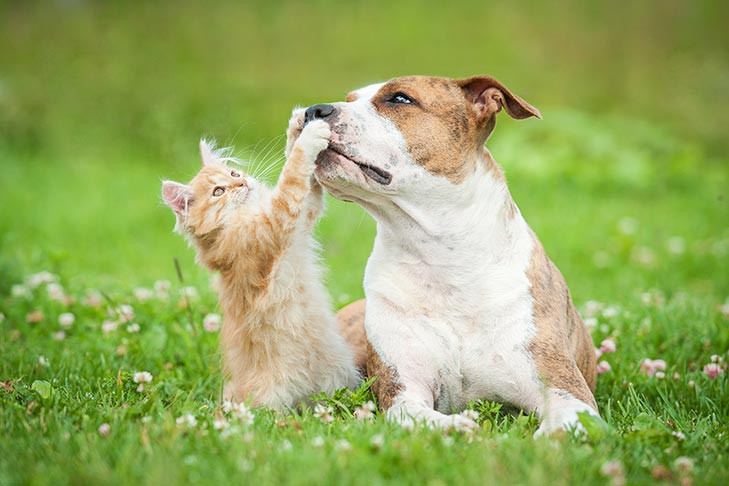Discovering your dog snacking on cat poop can be a truly unpleasant surprise for any pet owner. You’re not alone if you’ve found yourself asking, “Why on earth does my dog eat cat poop?”. While it might seem disgusting to us, coprophagia, or the act of eating feces, is a surprisingly common behavior in dogs. Understanding the reasons behind this habit, and whether it poses any risks to your furry friend, is the first step in addressing it. This article delves into the science behind why dogs are drawn to cat poop, explores the potential health concerns, and provides practical strategies to help you curb this undesirable behavior.
The Canine Fascination with Feline Feces: Decoding the Behavior
Dogs are natural scavengers, a trait inherited from their wild ancestors. This scavenging instinct means they are often attracted to things we might find repulsive, and that includes the waste products of other animals. Cat poop, in particular, seems to hold a special allure for many dogs. But what exactly makes cat poop so irresistible to our canine companions?
One key factor is the smell. To a dog’s highly sensitive nose, cat poop doesn’t smell like waste; it smells like food. High-quality cat food is typically rich in protein and fats, ingredients that are incredibly appealing to dogs. Undigested components of cat food remain in the feces, making it a fragrant and enticing snack in the eyes of a dog. Essentially, your dog might perceive cat poop as pre-digested cat food, a gourmet treat in their scavenging world.
Furthermore, the act of eating poop, scientifically known as coprophagia, can sometimes be linked to nutritional deficiencies, although this is less common in cases of dogs eating cat poop specifically. In some instances, dogs may consume feces to try and obtain missing nutrients, particularly digestive enzymes or vitamins. However, when dogs target cat poop, it’s more likely driven by the palatable scent and taste associated with the undigested cat food remnants.
Another contributing factor could be simple behavioral exploration. Dogs explore their world through scent and taste. Especially for puppies and younger dogs, investigating and even consuming cat poop can be part of their exploratory behavior. Over time, if not addressed, this exploration can unfortunately develop into a habitual behavior. Additionally, maternal instincts play a role in some cases. Mother dogs naturally consume the feces of their puppies to keep the den clean, a behavior that might, in some dogs, extend to other types of feces later in life.
Is Cat Poop Consumption Risky for Dogs? Potential Health Hazards
While the reasons behind coprophagia in dogs might be rooted in natural instincts, it’s crucial to understand that eating cat poop is not without potential risks. Although many dogs might indulge in this habit without immediate apparent harm, there are several health concerns associated with consuming feline feces.
One primary concern is the transmission of bacteria and parasites. Cat poop can harbor various harmful bacteria, such as Salmonella and E. coli, which can cause gastrointestinal upset in dogs, leading to symptoms like vomiting, diarrhea, and lethargy. These bacteria can also pose a risk to humans in the household through fecal-oral transmission.
Furthermore, cat poop can be a source of internal parasites. Cats can carry various intestinal parasites, including roundworms, hookworms, and Giardia, even without showing obvious symptoms. If a dog ingests cat poop contaminated with parasite eggs or larvae, they can become infected, requiring veterinary treatment to eliminate the parasites.
 American Staffordshire Terrier affectionately nuzzles a playful kitten outdoors
American Staffordshire Terrier affectionately nuzzles a playful kitten outdoors
Beyond biological hazards, cat litter itself presents another potential problem. If ingested in significant quantities, cat litter, especially clumping varieties, can cause intestinal blockages in dogs. Clumping litter is designed to absorb moisture and solidify, and if a dog consumes a large amount, it can clump together in their digestive tract, leading to a potentially life-threatening obstruction. While a small amount of litter ingestion is unlikely to cause serious issues, it’s still a risk to be aware of. Monitor your dog for signs of constipation, straining to defecate, or loss of appetite if you suspect they’ve consumed a considerable amount of cat litter.
Despite these potential risks, it’s important to note that many dogs eat cat poop without experiencing severe health consequences. However, the potential for illness and parasite transmission is always present. For both your dog’s well-being and your family’s health, discouraging this habit is highly recommended.
Strategies to Deter Your Dog from Eating Cat Poop: Prevention is Key
The most effective approach to dealing with coprophagia related to cat poop is prevention. Creating an environment where your dog cannot access the litter box is paramount. Here are some practical and veterinarian-recommended strategies to help you break your dog’s cat poop-eating habit:
1. Litter Box Location, Location, Location: The simplest solution is often the most effective. Place the cat litter box in a location that is completely inaccessible to your dog. This could be a room your dog cannot enter, such as a spare bedroom or laundry room, secured with a baby gate or pet gate. Ensure the gate is tall enough that your dog cannot jump over it and that your cat can easily pass through (many pet gates have a small cat door).
2. Utilize Vertical Space: Cats are natural climbers, so leveraging vertical space can be highly effective. Place the litter box on an elevated surface, like a sturdy table or shelf, that your cat can easily reach but your dog cannot. Ensure the surface is stable and secure to prevent accidents.
3. Covered or Top-Entry Litter Boxes: Invest in a covered cat litter box. These boxes provide more privacy for your cat and can deter some dogs, but determined dogs may still find a way in. For a more dog-proof option, consider a top-entry litter box. These boxes require cats to jump in from the top, making it significantly more challenging for most dogs to access the contents.
4. Consistent and Immediate Clean-Up: Regularly scooping the litter box, ideally once or twice daily, drastically reduces the temptation for your dog. Less poop in the litter box means less opportunity for your dog to snack. Dispose of scooped waste immediately and securely.
5. Training and Positive Reinforcement: Train your dog to “leave it” or “drop it” on command. These commands can be invaluable in redirecting your dog away from the litter box if they do manage to get close. Reward your dog with praise and treats when they obey these commands and ignore the litter box. Positive reinforcement is much more effective than punishment.
6. Address Potential Underlying Issues: While less common in cat poop consumption, if your dog eats other types of feces as well, consult with your veterinarian to rule out any underlying medical conditions or nutritional deficiencies that might be contributing to coprophagia. They can advise on dietary adjustments or supplements if needed.
7. Outdoor Vigilance: If neighborhood cats are the source of temptation in your yard, try to deter them humanely. Cat repellents, motion-activated sprinklers, or citrus peels in your garden might discourage cats from using your yard as a litter box. Always supervise your dog when they are outside and promptly clean up any feces you find.
By implementing these preventative measures consistently, you can significantly reduce or eliminate your dog’s access to cat poop and break this unpleasant habit. Remember that patience and consistency are key. If you are struggling to manage coprophagia, don’t hesitate to consult with your veterinarian or a certified professional dog trainer for personalized guidance and support.

